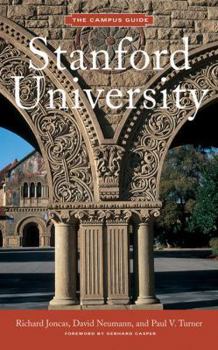Stanford University: An Architectural Tour
Select Format
Select Condition 
Book Overview
The unique settings and circumstances of American college campuses have given rise to some of the richest and most innovative examples of architecture and planning in the United States. These campuses... This description may be from another edition of this product.
Format:Paperback
Language:English
ISBN:156898538X
ISBN13:9781568985381
Release Date:January 2006
Publisher:Princeton Architectural Press
Length:200 Pages
Weight:1.36 lbs.
Dimensions:0.7" x 6.5" x 9.9"
Grade Range:Grade 8 to Postsecondary
Customer Reviews
1 rating
Stanford as a collection of buildings
Published by Thriftbooks.com User , 17 years ago
This is another volume is the Princeton series on U.S. universities, using a similar format: the campus is divided into "walks," with each chapter covering one walk and commenting on each building. As one reviewer here did not seem to understand, this is not the insider's guide to Stanford, nor even a full history of the University. That said, the reviewer made a telling criticism: in a campus defined by its setting, showing the buildings without showing the surrounding trees and open areas gives a false sense of the appearance of the place. When compared with other volumes in this series, "Stanford" is a little better than average. The entries are brief and factual, without the rather elliptical architecture speak that characterizes some of the Ivy League volumes. Most buildings are represented by a small photograph. There are a very few full page pictures. Based on the date of publication, this book was not written for the Princeton series, but was adapted for it. The maps appear to have been added more recently, and the method of presentation is different from the other volumes. Here, the buildings are considered not by location but by period, starting with the original structures (including ones destroyed in the 1906 quake) and proceeding up to the present. This means that adjacent entries are adjacent in date of construction, not location. Building 71 may be half a mile away from building 72. In the original publication, written for a Stanford audience, this was not a problem, but it may be difficult for those who do not know the campus. There are a number of errors in the maps, with some buildings not listed or not marked on the maps. Finally, a few entries seem wrong: Toyon hall is listed a dormitory for 150 men. Hmm... that's what it was when built, and perhaps (I doubt this) it is today. When I lived there 20 years ago, it was a dorm for about 230 men and women. Nice picture though. In fairness, the chronological approach is more logical, even if it makes it harder to read the maps. It allows the reader to see how building one structure can change the look and the traffic patterns of a large part of the campus. On the whole then, I recommend this book as a good way to see Stanford, so long as you understand the limitations of this kind of history. Just don't look for pictures of the tree or LSJUMB!






